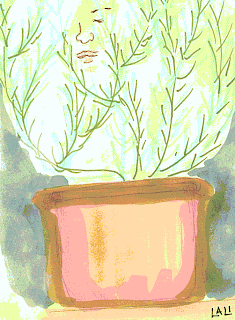Took advantage of a heat wave (35F and no wind) today and went for a ramble in the woods behind the house, with Wolfie.
The snow was deep, and the woods were silent. Wolfie led me to the remains—a few orange feathers on the snow—of the hen that died in early winter. I had given her an eco-burial by leaving her under a tree and hoping that some creature would make a meal of her. The snow all around the feathers was crisscrossed with tracks, mostly fox and coyote.
While Wolfie methodically smelled the feathers, the tracks, and the tree trunks against which something had sprayed or scratched, I smelled nothing. I heard nothing. In winter the ears, but especially the nose are largely deprived of stimuli by Nature. (The human nose, that is. The canine nose is never deprived of anything.)
Inside my house, however, it's a different story. This winter's challenge is to keep alive a large rosemary bush that I brought inside in the fall. Rosemary cannot survive Vermont winters outdoors, but it is almost as difficult to get it to survive indoors.
Because my plant-guru friend Dona had admonished me that rosemary hates to be moved, at Christmas we had to jam the tree in a less-than optimal corner, because I refused to upse t the rosemary by moving it. A native of the semi-arid Mediterranean, rosemary promptly gives up the ghost if it is over-watered. On the other hand, the indoor climate in winter can be Sahara-like, and rosemary's needle-thin leaves will dry up and drop off even as you fill the watering can. Every morning, in my pajamas, I can be seen spritzer in hand spritzing the rosemary, trying my best to give the effect of morning dew, and looking for signs of trouble.
t the rosemary by moving it. A native of the semi-arid Mediterranean, rosemary promptly gives up the ghost if it is over-watered. On the other hand, the indoor climate in winter can be Sahara-like, and rosemary's needle-thin leaves will dry up and drop off even as you fill the watering can. Every morning, in my pajamas, I can be seen spritzer in hand spritzing the rosemary, trying my best to give the effect of morning dew, and looking for signs of trouble.
I am happy to report that, after some initial pouting, the rosemary has settled in for the duration, and covered itself all over with tiny azure blooms. But the best part of the rosemary bush is that when I stroke it, or when Wolfie whacks it with his tail, it releases the smell of a Mediterranean hillside.
Next to the rosemary huddles a smaller lavender plant that I brought inside because I felt sorry for it, even though certain kinds of lavender are supposed to be able to take the winters here. It's starting to look kind of scraggly, despite careful waterings and spritzings, but I think that as the light grows stronger in the south-facing sun room in which it lives, it will cheer up. Meanwhile, it too gives off that Mediterranean smell.
Then there are the lemon/rose-scented geraniums. Unlike the rosemary and lavender, these are practically indestructible. Give them a bit of sun and they will grow as if they had been designed by Nature to live indoors. To keep their bushy shape, I periodically pinch off their top leaves, which makes my fingers smell delicious. Then I carefully dry and store the prunings for future pot-pourris. I've heard that you can pour boiling water over scented-geranium leaves and make tea, but I haven't tried that yet.
Lastly, there is the orange peel, which I save and set out to dry in a basket on the dining room table. When it's brittle I snap it into tiny pieces and store it in an old blue canning jar, where it looks nice. Orange peel works well as a fixative for pot-pourri, and smells terrific.
Rosemary, lavender, orange, geraniums.... I forgot to mention my little laurel tree! In the midst of a Vermont winter, I am surrounded by the plants and smells of a Catalan summer. A small miracle, but it will help me survive until lilac-time.

oh, yum, i love all of those smells!
ReplyDeletebut lilacs most of all.